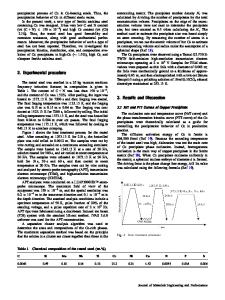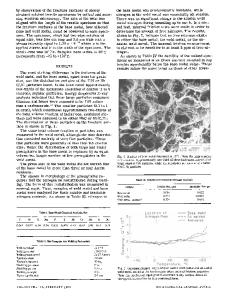Precipitation Kinetics in a Nb-stabilized Ferritic Stainless Steel
- PDF / 2,358,897 Bytes
- 10 Pages / 593.972 x 792 pts Page_size
- 106 Downloads / 345 Views
DUCTION
IN the last 15 years, austenitic stainless steels have been gradually replaced by ferritic stainless steels in automotive exhaust systems, for which the temperature of the exhaust gas tends to be increased above 1173 K (900 °C) for fuel economy and for cleaning the gas emissions.[1–6] Ferritic stainless steels present several advantages. First, they are not subjected to the fluctuation of nickel price. Second, during thermal cycles, ferritic grades are characterized by a much smaller thermal dilatation than austenitic grades, leading to a reduction of the stresses between the metal and the oxide layer developed on its surface. Consequently, fewer cracks are formed in the oxide layer and the oxide barrier remains more continuous, decreasing the oxidation kinetics.[1] However, ferritic grades have poorer mechanical properties in terms of high temperature
M. LABONNE, A. GRAUX, S. CAZOTTES, M. PEREZ, and V. MASSARDIER are with the Univ. Lyon, INSA Lyon, MATEIS UMR CNRS 5510, Baˆt. Saint-Exupe´ry, 25 avenue J. Capelle, 69621 Villeurbanne Cedex, France. Contact e-mail: [email protected] F. DANOIX and F. CUVILLY are with the Normandie Univ, UNIROUEN, INSA Rouen, CNRS, Groupe de Physique des Mate´riaux, 76000 Rouen, France. F. CHASSAGNE is with the APERAM Research Center, BP15, 62330 Isbergues, France. Manuscript submitted March 13, 2017. Article published online May 31, 2017 METALLURGICAL AND MATERIALS TRANSACTIONS A
strength,[2,3,5,7] which is detrimental for their resistance to thermal fatigue. This is the reason for which niobium is commonly added in ferritic stainless steels, due to its positive influence on mechanical properties.[1–5,7] Strength at elevated temperature can be substantially improved with the addition of niobium through solid solution and/or precipitation strengthening. In particular, grain boundary precipitation may occur, leading to an improved creep resistance.[7] Furthermore, the addition of small amounts of niobium in ferritic stainless steels was found to lead to a general grain refinement in the as-cast microstructures.[8] Lastly, niobium prevents the precipitation of Cr23C6 chromium carbides at grain boundaries. The formation of these carbides is believed to be deleterious because it leads to a depletion of the chromium content of the matrix surrounding the grain boundaries in which chromium carbides have formed[9]: this can result in a poor resistance to intergranular corrosion if the local composition of chromium falls below the critical value of 12 pct. When niobium is added, carbon reacts preferentially with this element rather than with chromium, preventing the risk of intergranular corrosion.[10] In the literature,[2–5,7,10–13] three types of precipitates have been identified as playing a role in the strengthening mechanisms of Nb-stabilized ferritic stainless steels: Nb(C, N) (carbonitride), Fe2Nb (Laves phase), and Fe3Nb3X (M6C carbide), where X stands for C or N. VOLUME 48A, AUGUST 2017—3655
However, two main points currently need to be addressed and will be disc
Data Loading...











